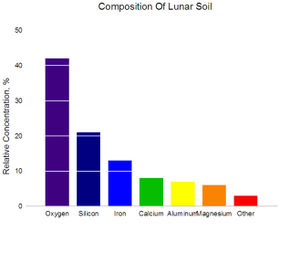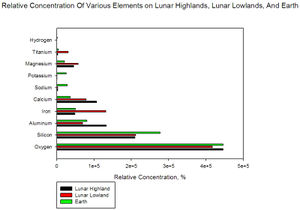Difference between revisions of "Lunar Regolith"
(→External Links: more links) |
Jarogers2001 (talk | contribs) (added fluorine reaction) |
||
| Line 1: | Line 1: | ||
| − | The layer of debris which blankets most of the moon is commonly refered to as | + | {{Stub}}<BR/>[[Image:658px-Moon_Comp_Graph.JPG|thumb|Relative Concentration Of Various Elements On The Lunar Surface]] |
| + | [[Image:800px-Moon_VS_Earth_Composition.JPG|thumb|Relative Concentration (in weight ppm) of Various Elements on Lunar Highlands, Lunar Lowlands, and Earth]] | ||
| + | The layer of debris which blankets most of the moon is commonly refered to as regolith. Billions of years of bombardment from space has created a highly comminuted (this means it has been broken into ever smaller grains and particles) surface through a process sometimes referered to as "impact gardening" or "space weathering." It is estimated that the regolith varies in thickness from 3 to 5 meters over the younger "maria" to approximatly 10 to 20 meters thick in the older "highlands." Below the impact regolith is a layer of "mega-regolith" consisting of highly fractered bedrock that is tens of kilometers thick. | ||
| + | <BR/><BR/> | ||
| + | The portion of the regolith of a size less than 1cm is generally referred to as [[Lunar Soil]], and the dusty, abrasive portion is referred to as [[Lunar Dust]] or "Fines." | ||
| + | <BR/><BR/> | ||
| + | Lunar regolith is the focus of many proposed methods of [[LUNOX | oxygen production]] and [[In Situ Resource Utilization | in-situ resource utilization]] including: | ||
| + | *[[Ilmenite Reduction]] | ||
| + | *[[Fluorine reaction]] | ||
| + | *[[Glass Reduction]] | ||
| + | *[[Radiation shielding]] | ||
| + | *[[Volatile scavenging]] | ||
| − | |||
| − | |||
| − | |||
==External Links== | ==External Links== | ||
*Lunar Soil at Wikipedia.org [http://en.wikipedia.org/wiki/Lunar_soil http://en.wikipedia.org/wiki/Lunar_soil] | *Lunar Soil at Wikipedia.org [http://en.wikipedia.org/wiki/Lunar_soil http://en.wikipedia.org/wiki/Lunar_soil] | ||
| − | + | *PERMANENT.com [http://permanent.com/ http://permanent.com/] | |
| + | *ISRU on the Moon. by Larry Taylor [http://www.lpi.usra.edu/lunar_knowledge/LTaylor.pdf http://www.lpi.usra.edu/lunar_knowledge/LTaylor.pdf] (PDF)<BR/> | ||
[[Category:Selenology]] | [[Category:Selenology]] | ||
| − | + | [[Category:ISRU]] | |
| − | |||
| − | [[Category:ISRU]] | ||
| − | |||
| − | |||
| − | |||
| − | |||
| − | |||
Revision as of 19:29, 1 April 2007
| This article is a stub. You can help Lunarpedia by expanding it or sorting it into the correct stub subcategory. |
The layer of debris which blankets most of the moon is commonly refered to as regolith. Billions of years of bombardment from space has created a highly comminuted (this means it has been broken into ever smaller grains and particles) surface through a process sometimes referered to as "impact gardening" or "space weathering." It is estimated that the regolith varies in thickness from 3 to 5 meters over the younger "maria" to approximatly 10 to 20 meters thick in the older "highlands." Below the impact regolith is a layer of "mega-regolith" consisting of highly fractered bedrock that is tens of kilometers thick.
The portion of the regolith of a size less than 1cm is generally referred to as Lunar Soil, and the dusty, abrasive portion is referred to as Lunar Dust or "Fines."
Lunar regolith is the focus of many proposed methods of oxygen production and in-situ resource utilization including:
External Links
- Lunar Soil at Wikipedia.org http://en.wikipedia.org/wiki/Lunar_soil
- PERMANENT.com http://permanent.com/
- ISRU on the Moon. by Larry Taylor http://www.lpi.usra.edu/lunar_knowledge/LTaylor.pdf (PDF)








